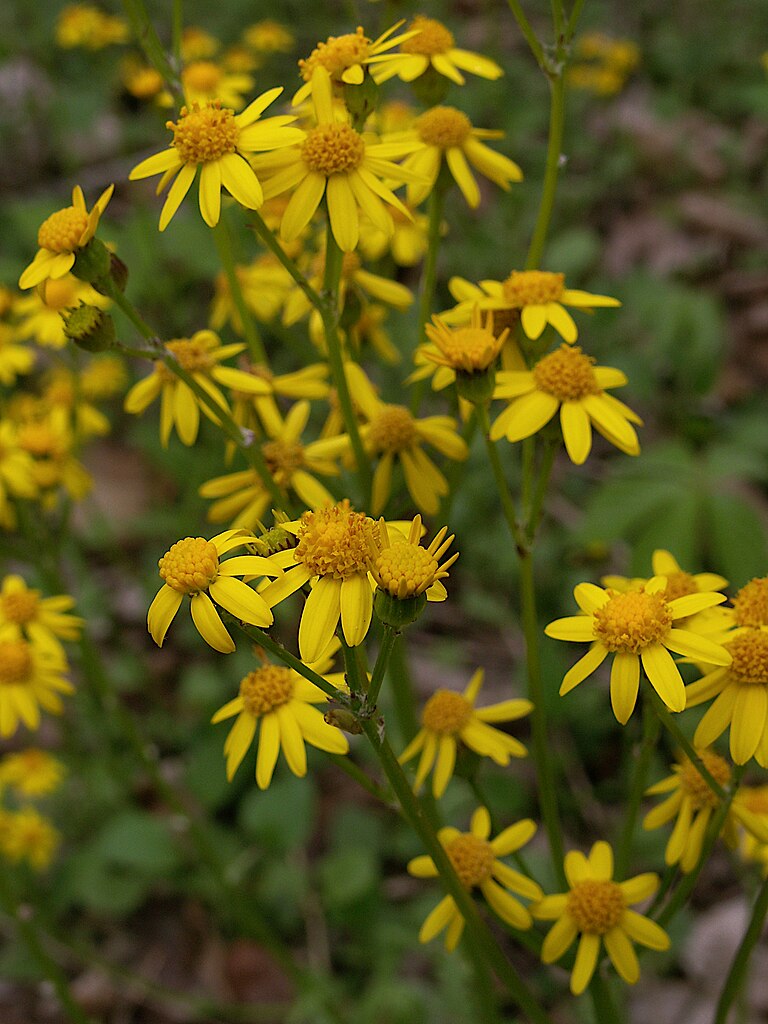
Like bright yellow asters, these cheery composite flowers come out in time for Mayday. These were blooming in the Kane Woods Nature Area in Scott Township. There is nothing else like them blooming in the spring around here, so they are easy to recognize.
This species was formerly included as Senecio aureus in the huge genus Senecio, but a group of Senecios were separated into the genus Packera on genetic and morphological grounds. Because the genera have been rearranged, we take the description of Packera aurea from the Flora of North America, where it is licensed under a Creative Commons Attribution 4.0 International license.
Packera. Annuals, biennials, or perennials, 3–100+ cm (rhizomatous or taprooted, often with relatively thin, branched fibrous roots). Stems single or clustered. Leaves basal and cauline (gradually or abruptly reduced distally); alternate; petiolate (mostly basal) or sessile; blades pinnately nerved, elliptic, lanceolate, linear, lyrate, orbiculate, ovate, reniform, or spatulate (and most intermediate shapes, blades often pinnately lobed to pinnatifid or pinnatisect), ultimate margins entire or crenate, dentate, or serrate to denticulate (callous denticles relatively few or 0). Heads radiate or discoid, borne singly or in compact or congested to open, corymbiform, cymiform, or subumbelliform arrays. Calyculi 0 or 1–5+ bractlets. Involucres campanulate to cylindric, 5–12 mm diam. Phyllaries persistent, usually 8, 13, or 21(–30+) in 1–2 series, erect (reflexed in fruit), distinct, (light to dark green, yellowish, reddish, or cyanic) linear to ensiform, equal to subequal (glabrous or hairy), margins usually ± scarious. Receptacles flat, foveolate, epaleate. Ray florets 0 or (1–)5–13, pistillate, fertile; corollas pale yellow to orange-red (tubes 1–4 mm, laminae 4–16 mm). Disc florets 20–80+, bisexual, fertile; corollas pale yellow to deep orange-red, tubes shorter than to equaling campanulate throats, lobes 5, erect to recurved, usually ± deltate; style branches stigmatic in 2 lines, apices usually truncate-penicillate. Cypselae cylindric, usually 5–10-ribbed (ribs usually prominent), glabrous or hirtellous; pappi readily falling, of ± 60+, white, barbellulate bristles. x = 20, 22, 23.
Packera aurea. Perennials, 30–60+ cm; rhizomatous and/or fibrous-rooted (rhizomes or caudices erect to horizontal). Stems 1 or 2–3+, clustered, glabrous or leaf axils tomentose. Basal leaves petiolate; blades cordate to reniform, 20–60 × 20–60 mm, bases abruptly contracted or ± cordate, margins crenate to crenate-serrate (apices rounded, faces glabrous). Cauline leaves gradually reduced (petiolate or sessile, not clasping; blades oblong to lyrate, lateral lobes 2–4 pairs). Heads 6–20+ in corymbiform to subumbelliform arrays. Peduncles bracteate, glabrous or sparsely tomentose. Calyculi inconspicuous. Phyllaries 13–21, green (tips purple or black), 6–8 mm, glabrous or sparsely tomentose proximally. Ray florets (8–)10–13; corolla laminae 8–10+ mm. Disc florets 55–70+; corolla tubes 3–3.5 mm, limbs 2–2.5 mm. Cypselae 1–1.5 mm, glabrous; pappi 4.5–5.5 mm. 2n = 44.